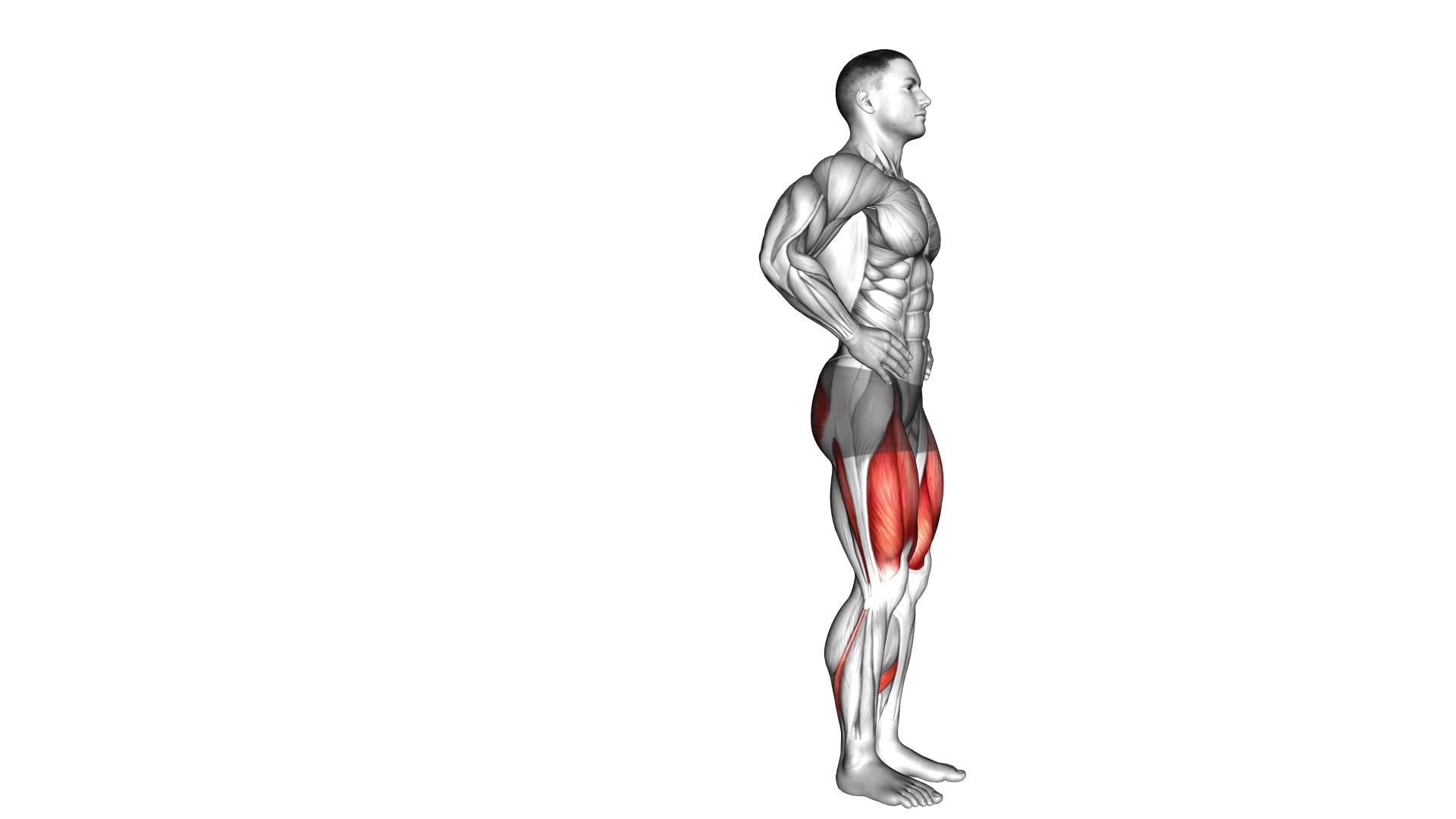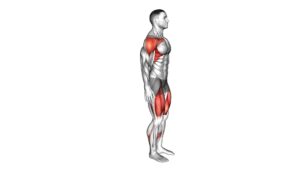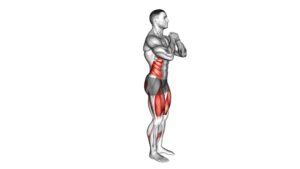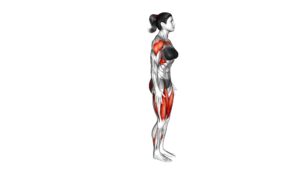Bodyweight Rear Lunge – Video Exercise Guide & Tips

Are you looking to amp up your leg workout routine? Try the bodyweight rear lunge!
Watch This Exercise Video
This exercise targets your glutes, quads, and hamstrings, helping you build strength and tone.
In this video exercise guide, we'll show you the proper form and technique, common mistakes to avoid, and modifications for beginners.
For the experienced fitness enthusiasts, we'll also share advanced variations.
Get ready to maximize your results and take your leg day to the next level!
Key Takeaways
- Bodyweight rear lunges activate and strengthen lower body muscles.
- They improve cardiovascular endurance and lung capacity.
- The exercise targets quadriceps, hamstrings, glutes, and calves.
- Engaging core muscles for stability and balance is crucial during rear lunges.
Benefits of Bodyweight Rear Lunges
When performing bodyweight rear lunges, you can experience numerous benefits by incorporating this exercise into your workout routine.
This exercise is a great way to activate and strengthen your muscles while also improving your cardiovascular endurance.
Bodyweight rear lunges primarily target the muscles in your lower body, including your quadriceps, hamstrings, glutes, and calves. By engaging these muscles, you can improve your overall lower body strength and stability. Additionally, the controlled movement required during rear lunges helps to activate and engage your core muscles for added stability and balance.
Incorporating bodyweight rear lunges into your workout routine can also improve your cardiovascular endurance. This exercise gets your heart rate up and requires continuous movement, which helps to increase your cardiovascular fitness over time. By regularly including rear lunges in your workouts, you can improve your lung capacity, stamina, and overall cardiovascular health.
Proper Form and Technique
To perform bodyweight rear lunges with proper form and technique, follow these guidelines:
- Keep your upper body straight: Maintain good posture throughout the exercise by keeping your chest up and shoulders back. This will help engage your core muscles and prevent unnecessary strain on your back.
- Step back with control: When stepping back into the lunge position, lower your body slowly and under control. Avoid rushing the movement, as this can lead to loss of balance and potential injury.
- Maintain proper alignment: As you lunge, make sure your front knee stays directly above your ankle and your back knee hovers just above the ground. This will ensure that you're targeting the correct muscles and minimizing stress on your joints.
Contrary to common misconceptions, bodyweight rear lunges can be performed without any equipment. They're a highly effective exercise that can be done anywhere, anytime. However, if you prefer to add resistance, you can hold dumbbells or use a barbell across your shoulders.
Common Mistakes to Avoid
To avoid common mistakes and ensure proper form, focus on maintaining proper alignment and control during bodyweight rear lunges.
One of the most common mistakes people make is allowing their knee to extend past their toes during the lunge. This puts excessive stress on the knee joint and can lead to injury. To prevent this, make sure to keep your knee directly above your ankle throughout the movement.
Another mistake to avoid is leaning too far forward. This can put strain on your lower back and take away from the effectiveness of the exercise. Instead, keep your torso upright and engage your core to maintain stability.
It's also important to avoid rushing through the movement. Take your time and focus on controlled, deliberate movements to maximize the benefits of the exercise.
Lastly, be mindful of your foot placement. Keep your foot firmly planted on the ground and distribute your weight evenly between your front and back legs.
Modifications for Beginners
If you're new to bodyweight rear lunges, there are a few modifications you can make to make the exercise more accessible. Here are three beginner modifications that you can try:
- Start with a shorter step: Instead of taking a long step back, begin with a shorter step. This will reduce the distance you have to move and help you maintain balance and stability.
- Use a support: If you find it challenging to balance during the exercise, try using a support. You can hold onto a chair or wall for added stability. This will allow you to focus on your form and gradually build strength and confidence.
- Perform a static lunge: Instead of continuously stepping back and forth, you can try a static lunge. In this modification, you'll step back into a lunge position and hold it for a few seconds before returning to the starting position. This will help you develop strength and stability in your legs before progressing to dynamic lunges.
By implementing these modifications, you can gradually build up your strength and technique with bodyweight rear lunges.
Remember to listen to your body and start at a level that feels comfortable for you. As you become more comfortable and confident, you can gradually increase the difficulty of the exercise.
Advanced Variations for Experienced Fitness Enthusiasts
For experienced fitness enthusiasts, there are several advanced variations of the bodyweight rear lunge that can be incorporated into your workout routine to challenge your strength and stability even further. These advanced modifications are perfect for those looking to increase the intensity of their lunges and take their fitness to the next level.
One advanced variation is the jump lunge. To perform this exercise, start in a lunge position with one leg forward and the other leg extended behind you. From here, explosively jump into the air, switching the position of your legs mid-air, and land with the opposite leg forward. This explosive movement not only targets your legs but also engages your core and improves your cardiovascular endurance.
Another advanced modification is the weighted rear lunge. Holding a dumbbell or kettlebell in each hand, step back into a lunge position and then return to the starting position. The added resistance from the weights increases the intensity of the exercise and helps to further strengthen your lower body muscles.
Lastly, you can try the Bulgarian split squat. This variation requires you to elevate your back foot on a bench or step. From here, lower your body down into a lunge position and then push through your front heel to return to the starting position. The Bulgarian split squat not only challenges your leg muscles but also improves your balance and stability.
Incorporating these advanced variations into your workout routine will help you continue to progress and achieve your fitness goals. Remember to start with proper form and gradually increase the intensity as you become more comfortable and confident.
Tips for Maximizing Results
To maximize your results with the bodyweight rear lunge, focus on proper form and gradually increase the intensity as you become more comfortable and confident. Here are some tips to help you maximize your muscle activation and get the most out of this exercise:
- Engage your core: Throughout the movement, make sure to engage your core muscles by pulling your belly button in towards your spine. This won't only help you maintain stability but also increase the activation of your abdominal muscles.
- Maintain proper alignment: Keep your chest lifted and your shoulders relaxed as you perform the rear lunge. Avoid leaning forward or rounding your back, as this can put unnecessary strain on your lower back. Maintaining proper alignment will ensure that you're targeting your glutes and leg muscles effectively.
- Vary your tempo: To challenge your muscles even further, try incorporating different tempos into your rear lunges. Slow down the movement on the way down and explode up on the way back to the starting position. This will help increase muscle activation and enhance your overall strength and power.
The best time to perform bodyweight rear lunges is during your lower body or leg workout. Incorporating this exercise into your routine will help you build strength and endurance in your glutes, hamstrings, and quadriceps.
Remember to listen to your body and adjust the intensity and frequency of the exercise to suit your fitness level and goals.
Frequently Asked Questions
How Many Calories Does a Bodyweight Rear Lunge Burn?
The bodyweight rear lunge is a great exercise for burning calories and improving overall fitness. When performed correctly, this exercise can help you burn a significant amount of calories.
In addition to calorie burn, bodyweight rear lunges also offer numerous benefits such as strengthening the lower body muscles, improving balance, and increasing flexibility.
Incorporating this exercise into your workout routine can contribute to weight loss and overall fitness goals.
Can Bodyweight Rear Lunges Help Improve Balance and Stability?
Bodyweight rear lunges are a great exercise to improve your balance and stability. By incorporating this exercise into your routine, you can enhance your coordination and strengthen your lower body.
The movement requires you to engage your core and focus on maintaining proper form, which can help improve your overall stability.
Additionally, the exercise targets your glutes, quadriceps, and hamstrings, making it an effective way to build lower body strength.
Are Bodyweight Rear Lunges Safe for Individuals With Knee or Hip Issues?
Bodyweight rear lunges can be a safe exercise option for individuals with knee or hip issues. However, it's important to modify the exercise to suit your needs. By taking smaller steps and focusing on proper form, you can reduce the strain on your joints.
The benefits of bodyweight rear lunges include improved leg strength, balance, and stability. Always listen to your body and consult with a healthcare professional if you have any concerns or questions.
How Many Sets and Repetitions Should Be Performed for Optimal Results?
To achieve optimal results, it's important to consider the number of sets and repetitions you perform during bodyweight rear lunges. Sets refer to the number of times you complete a group of repetitions, while repetitions are the number of times you perform the exercise.
The specific number of sets and repetitions may vary depending on your fitness goals and experience level. By adjusting these variables, you can optimize muscle activation and progress towards your desired results.
Can Bodyweight Rear Lunges Be Incorporated Into a Full-Body Workout Routine?
Including bodyweight rear lunges in your full-body workout routine offers several benefits.
- It targets multiple muscle groups, including your quads, glutes, and hamstrings.
- This exercise also improves balance and stability.
- To accommodate different fitness levels, you can modify the exercise by using a chair or wall for support or adding weights for increased intensity.
- Incorporating bodyweight rear lunges into your routine will help you build strength and improve overall fitness.
Conclusion
In conclusion, bodyweight rear lunges are a highly effective exercise that target multiple muscle groups in the lower body.
By maintaining proper form and technique, you can maximize the benefits and avoid common mistakes.
Beginners can modify the exercise to suit their fitness level, while experienced fitness enthusiasts can challenge themselves with advanced variations.
Remember to follow these tips to achieve optimal results and improve your overall fitness.

Author
Years ago, the spark of my life’s passion ignited in my mind the moment I stepped into the local gym for the first time. The inaugural bead of perspiration, the initial endeavor, the very first surge of endorphins, and a sense of pride that washed over me post-workout marked the beginning of my deep-seated interest in strength sports, fitness, and sports nutrition. This very curiosity blossomed rapidly into a profound fascination, propelling me to earn a Master’s degree in Physical Education from the Academy of Physical Education in Krakow, followed by a Sports Manager diploma from the Jagiellonian University. My journey of growth led me to gain more specialized qualifications, such as being a certified personal trainer with a focus on sports dietetics, a lifeguard, and an instructor for wellness and corrective gymnastics. Theoretical knowledge paired seamlessly with practical experience, reinforcing my belief that the transformation of individuals under my guidance was also a reflection of my personal growth. This belief holds true even today. Each day, I strive to push the boundaries and explore new realms. These realms gently elevate me to greater heights. The unique combination of passion for my field and the continuous quest for growth fuels my drive to break new ground.







